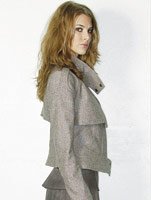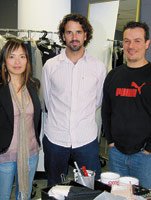Cardona's First Development Line to Bow at Coterie
Visitors to the Feb. 27– March 1 run of Fashion Coterie in New York will get the first look at the latest collection from Development, designed by the Los Angeles–based contemporary label’s new creative director, David Cardona.
The collection has been tapped to be among the labels showing in a new area of Coterie called “The Mezzanine.”
This marks the first time Development has shown at Coterie and the next step in the company’s strategy to grow the brand.
The company, founded four years ago by Mossimo veterans Andy Crane and Stu Gaddis, has practiced a slow-growth strategy, preferring to build a solid base of retailers for its subtle contemporary styles. “The emphasis is on tailoring rather than trendiness,” explained Crane, who said Cardona’s design style was a great fit for the company after designer Philip Lim left to launch his own collection in New York.
“We mesh on multiple levels,” Cardona said. “We see things the same way as far as the future of the company and how to get to those points. It’s rare that you’re able to meet someone who has similar aesthetics and similar goals.”
Cardona got his start with Richard Tyler before launching his own label, through which he established a reputation for understated, elegant style with a focus on tailoring and fit. The designer joined Development in November, shortly after he finished a one-year stint as womenswear design chief for Italian luxury brand Cerruti.
The Fall 2005 Development collection will blend Cardona’s tailoring skill with Development’s casual modern style.
“We’re looking for David to put his taste level and aesthetic into [the collection],” Crane said. “David started in November. He put his stamp on the collection; he put in 110 percent of the designing.”
The result is a mix of tailored trousers, jackets and coats in tropical- weight wool, washed cotton and menswear suitings, as well as fluid and architectural dresses and tops in silk jersey. Coats, jackets and slouchy handbags are trimmed in fur. The collection also incorporates seemingly disparate styles, such as slim, belted jackets and layered ballet skirts in satin and chiffon.
In addition, Cardona will serve as creative director of Development’s secondary label, White, designed by Amy Lui.
Crane described White as a more casual, item-driven line with a softer look and color story. Wholesale prices for White will run from $24 to $125, significantly less than the wholesale prices for Development, which will run from $68 to $385.
“[The key was] finding a creative director who can embrace the company as a whole,” Crane said. “It allows us to protect Development and grow it the way we want to grow it.”
Slow growth
Crane and Gaddis want to grow Development slowly, building on its core boutique business and expanding into other categories such as belts, handbags and jewelry.
“We’ve done a good job to protect the label,” Crane said. “In the next five years, we’d like to broaden the label to make it a brand.”
The company may also return to menswear, which it launched briefly in 2003, according to Crane.
“It did well, but from an infrastructure standpoint, it was too much for us,” he said. “We shipped what we took orders on and decided, ’Let’s postpone it.’”
Currently, Development sells at retailers such as Barneys New York, Henri Bendel, Madison, Harvey Nichols in London and Joyce in Hong Kong, as well as in a limited number of Bloomingdale’s stores.
“Better contemporary retailers have been incredibly supportive of us,” Crane said. “We give them good value product, quality service, and at the same time, we don’t overexpose the product.”
Most of the collection is manufactured in Los Angeles, except for a few sweaters that are produced overseas. One of the advantages to local production is the opportunity to keep inventory levels lean, Crane said.
“We break the line five times a year,” he said. “As we’re releasing lines, we may have to take a position on fabric, but we’re not taking a position on sizes and styles. We don’t sit on overproduced inventory.”
The entire operation for Development is lean, with about 22 employees working out of a 7,000-square-foot space in Vernon, Calif.
And while the company may outgrow its current space, Crane said he likes keeping much of the production domestic.
“We like to manufacture in the U.S.,” Crane said. “There’s just about nothing you can’t sew in L.A. There’s a great contractor base here. There’s a certain pride level doing it in the United States.”
—Alison A. Nieder
























